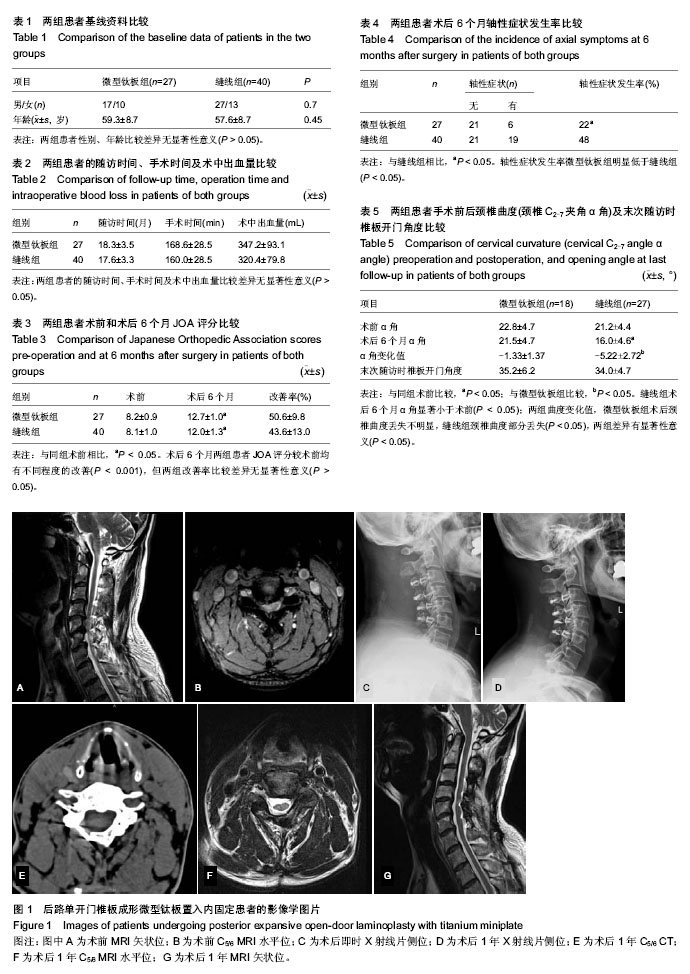| [1] Boogaarts HD, Bartels RH. Prevalence of cervical spondylotic myelopathy. Eur Spine J. 2013. [Epub ahead of print]
[2] Hirabayashi K, Miyakawa J, Satomi K, et al. Operative results and postoperative progression of ossification among patients with ossification of cervical posterior longitudinal ligament. Spine. 1981; 6(4): 354-364.
[3] Della Pepa GM, Roselli R, La Rocca G, et al. Laminoplasty is better of laminectomy in cervical stenotic myelopathy: myth or truth. Eur Rev Med Pharmacol Sci. 2014; 18(1 Suppl): 50-54.
[4] Satomi K, Ogawa J, Ishii Y, et al. Short-term complications and long-term results of expansive open-door laminoplasty for cervical stenotic myelopathy. Spine J. 2001; 1(1):26-30.
[5] 牛硕,孙宇.系统性回顾改良颈椎管扩大椎板成形术的疗效及其对轴性症状的影响[J].中国脊柱脊髓杂志, 2012, 22(1): 72-76.
[6] Suchomel P, Hradil J. Minimally invasive cervical elastic laminoplasty - principles and surgical technique. Acta Chir Orthop Traumatol Cech. 2011; 78(5): 437-441.
[7] Chen G, Luo Z, Nalajala B, et al. Expansive open-door laminoplasty with titanium miniplate versus sutures. Orthopedics. 2012; 35(4): e543-e548.
[8] 曾岩,党耕町,马庆军.颈椎前路融合术后颈部运动功能的评价[J].中华外科杂志, 2004, 42(24): 1481-1484.
[9] Matsumoto M, Watanabe K, Tsuji T, et al. Risk factors for closure of lamina after open-door laminoplasty. J Neurosurg Spine. 2008; 9(6):530-537.
[10] Matsumoto M, Watanabe K, Hosogane N, et al. Impact of lamina closure on long-term outcomes of open-door laminoplasty in patients with cervical myelopathy: minimum 5-year follow-up study. Spine. 2012; 37(15):1288-1291.
[11] 万军,张海森,张宇,等.比较单开门颈椎椎板成形术中锚定法与钛板固定对预防椎板关闭的效果[J].中华骨科杂志, 2013, 33(10): 977-983.
[12] 温世锋,郭东明,徐中和,等.微型钛板与锚定法颈椎单开门治疗颈椎病效果的对比研究[J].中国临床解剖学杂志, 2013, 31(3): 350-354.
[13] 俞阳,范海泉,陈铭,等. ARCH钢板在颈椎后路椎管成形术中的应用治疗颈椎后纵韧带骨化症近期疗效观察[J]. 重庆医学, 2013, 42(22): 2616-2618.
[14] Park AE, Heller JG. Cervical laminoplasty: use of a novel titanium plate to maintain canal expansion-surgical technique. J Spinal Disord Tech. 2004; 17: 265-271.
[15] Siribumrungwong K, Kiriratnikom T, Tangtrakulwanich B. Union Rate on Hinge Side after Open-Door Laminoplasty Using Maxillofacial Titanium Miniplate. Adv Orthop. 2013; 2013(2013):1-6.
[16] Hosono N, Sakaura H, Mukai Y, et al. The source of axial pain after cervical laminoplasty-C7 is more crucial than deep extensor muscles. Spine. 2007; 32(26): 2985-2988.
[17] Sakaura H, Hosono N, Mukai Y, et al. Preservation of muscles attached to the C2 and C7 spinous processes rather than subaxial deep extensors reduces adverse effects after cervical laminoplasty. Spine. 2010; 35(16): E782-E786.
[18] Sakaura H, Hosono N, Mukai Y, et al. Preservation of the nuchal ligament plays an important role in preventing unfavorable radiologic changes after laminoplasty. J Spinal Disord Tech. 2008; 21(5): 338-343.
[19] Wang SJ, Jiang SD, Jiang LS, et al. Axial pain after posterior cervical spine surgery: a systematic review. Eur Spine J. 2011; 20(2):185-194.
[20] Tanaka S, Tashiro T, Gomi A, et al. Cervical unilateral open-door laminoplasty with titanium miniplates through newly designed hydroxyapatite spacers. Neurol Med Chir (Tokyo). 2011; 51(9):673-677.
[21] Riew KD, Raich AL, Dettori JR, et al. Pain Following Cervical Laminoplasty: Does Preservation of the C2 Muscle Attachments and/or C7 Matter? Evid Based Spine Care J. 2013; 4(1): 42-53.
[22] Jiang JL, Li XL, Zhou XG, et al. Plate-only open-door laminoplasty with fusion for treatment of multilevel degenerative cervical disease. J Clin Neurosci.2012; 19(6): 804-809.
[23] Rhee JM, Register B, Hamasaki T, et al. Plate-only open door laminoplasty maintains stable spinal canal expansion with high rates of hinge union and no plate failures. Spine. 2011; 36(1): 9-14. |
